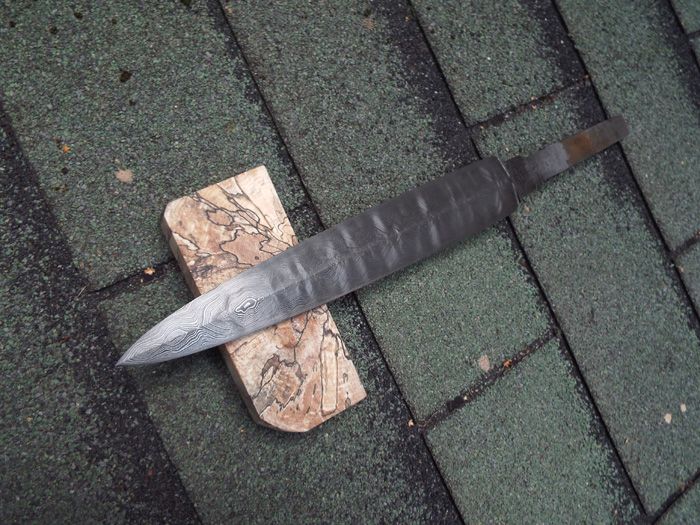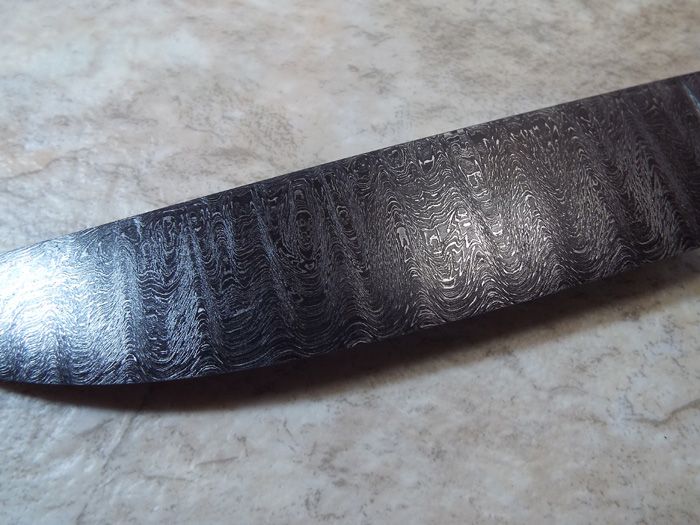For my time making Damascus the chatoyance of any given piece has been an off & on type of thing with some pieces fairly glittering and some just kind of laying there. I realize that some patterns are going to lend themselves much better to a high refraction or chatoyance then others but I'm thinking that the pattern isn't all of the equation. I would like to hear from you if you have found ways of improving it on your blades. Can chatoyance be engineered? Can any given pattern achieve a high chatoyance?
I'd appreciate your thoughts.
Thanks,
Gary
Gary, this is the result of my drawing dies on the last pass while forging to thickness.
Sort of a "pressed in ladder" if you will.
Also, while very near to last reduction when forging to thickness, a power hammer will upset things quite nicely as well.
Karl B. Andersen
Journeyman Smith
I think the layer count is important, as well. As I have done other cut in ladders on Ws blades, with much lower layer count that had little chatoyance.
Karl B. Andersen
Journeyman Smith
I agree - layer count is important. Under 200 layers or so won't have the same chatoyance as a 300 or 400 layer blade.
In my experience the etch is also very important. It needs to be deep enough, and create sufficient surface topography, to allow the opposing layers to reflect the light at differing angles, thus creating the "shimmer" we all like to see. This reflection of light at varying angles is, after all, the very essence of chatoyance.
One method I like to use is to polish the blade with a powder or paste abrasive between etchings in order to reach both the high and low spots between layers. I have found this polishing method to increase the level of chatoyance relative to a blade that has instead had its surface lightly sanded on an even plane (i.e. with a sanding stick) after being etched.
Others may have completely different experiences, however, and I'd be very interested to hear about their methods as well. Karl, you've made some real stunners and I for one would love to hear any tips or insights you'd be willing to share about your own etching and polishing techniques.
Thanks, guys. Good tips. Keep them coming.
Gary
I feel that it is mostly engineered. basically what we are talking about is the light reflection coming off the blade. If you take a plain carbon steel blade and rock it back and forth (long ways) under a light, you will see just a plain reflection.
Now, imagine that you had 50 layers of steel with all the layers perfectly parallel to the spine. By rocking the blade under the light, not much changes.
Take that same billet and twist it and the reflections start to get more exciting.
If you do a 4 way billet where the pattern gets tighter toward the center, the light reflects off of the pattern at different rates so the more the pattern changes, the faster the reflection of light changes and the more active the pattern appears. So by controlling your pattern development and/or your layer count, you control the way the light reflects off of your blade.
Brian
I too see this as engineered. At least, that sets the pattern up to have chatoyance. The actual finish has a lot to do with it of course. Without the set up you can polish till you're blue in the face and wont get the chatoyance.
The set up, in my experience, should have 350-400 layers. Also the pattern must be disrupted as much as possible in as short of distance as possible. Brian used the term "fast" to which I agree in my way of thinking. Traveling along the length of the blade, the pattern should be disrupted very "quickly", the topography going down and back up, as it were, in a short travel distance. Its as if you are almost "shearing" the layers. Again, almost. In the case of a ladder pattern, this would take place at regular intervals. The closeness of these intervals would tend to affect the steep angle of the offsets. Closeness being GOOD while spaced out too much is BAD as far as trying to achieve chatoyance. If the steep angle of the offsets(disruption) are maintained, then that is where the chatoyance happens, IMO. If you achieve disruption and then do too much drawing out of the blade, you will lose some or all of the chatoyance. So, again in my opinion, it is very important to engineer the diruptions into the pattern shortly before the blade has reached its final shape, including its profile and length.
Thanks everyone for the responses. They make me want to try them all. I won't get another chance to view everyone's steel until the ICCE Show. Since there has been a bit of a challenge to bring something special in the way of Damascus to the show, I'm sure that there will be plenty of beautiful examples chatoyance there. I haven't decided just what to work on but this thread has given me plenty of good ideas.
Thanks again.
B.T.W.--I hope that all in Oklahoma & Arkansas came through the nasty weather last night without injury or damage. Luckily here in the Ozarks we had mostly just heavy rain. <img src=' http://www.americanbladesmith.com/ipboard/public/style_emoticons//biggrin.gi f' class='bbc_emoticon' alt=':D' /> My little creek by the house is rocking & rolling this morning.
Gary
I made this short video to show how even a low layer damascus blade can have a bit of shimmer.
It's a simple twist pattern with only about 40 layers or so. I hand rubbed the blade to 400 grit, then gave it five etching cycles in ferric chloride, polishing thoroughly between cycles. The etch is fairly deep at this point. Polishing out the pattern with a high grit abrasive powder helps bring out that surface topography, which creates the shimmer effect when the light reflects off the steel at varying angles. It obviously doesn't have nearly the level of chatoyance that is possible with a higher layer count, but demonstrates simply the importance of thorough etching and polishing techniques in achieving the desired effect. (And yes Lin, I polished it til I was blue in the face <img src=' http://www.americanbladesmith.com/ipboard/public/style_emoticons//smile.gi f' class='bbc_emoticon' alt=':)' /> )




